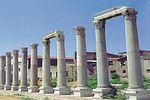İZMİR - AGORA
İzmir - Agora Museum
 Etymologically, agora means Public Square and shopping district. Agora, which has commercial, judicial and political functions, is a place where the art activities increase, the background of philosophy is laid out and where the stoas, monuments, altars and statues exist.
Etymologically, agora means Public Square and shopping district. Agora, which has commercial, judicial and political functions, is a place where the art activities increase, the background of philosophy is laid out and where the stoas, monuments, altars and statues exist.
Agora located in Namazgah district of İzmir remained from Rome Period (AD the 2nd century) and it was built according to Hippodamos city plan, on three floors, close to the centre. İzmir agora is the one which is the biggest and best protected of the Ion agoras.
Most part of İzmir agora was found with the digs carried out by Rudolf Naumann, Professor F. Miltner and Selahattin Kantar, the director of İzmir Ephesus museums between the years 1932 - 1941 and it was figured out that it is a three - floor compound structure in rectangular form with stairs in the front, built on columns and arches around a large courtyard (120 x 180 m) in the middle of the building.
Recent digs in agora begun on August 5th, 1996 with the approval of Ministry of Culture and cooperation of İzmir Governor Office and the Directorate of
Archaeology Museum.
At south east side of the agora, the area agora covered increased to 16.590 m² after the surrounding wall of Misak-ı Milli Primary School, which was burnt in 1980s, was jointed to agora. The agora studies are being carried out with the sponsorship of İzmir Municipality as digging, restoration, archaeological cleaning and environmental arrangement at five places such as agora area, northern gate basilica bottom, stoa and ancient shopping centre.
At the above-mentioned studies, the most important work has been carried out by finding the northern gate of agora. It was figured out that the Goddess Vesta embossments found in these digs were the continuation of embossments of Zeus altar extracted during the first digs. Beside God Hermes, Dionysus, Eros, Herakles statues; many man-woman-animal statues, heads, embossments, figurines and monuments made of marble, stone, bone, glass, metal and cooked soil were found. The inscriptions found here give us information about the people who aided to İzmir during İzmir earthquake in AD 178. • Return to General Directorate of Monuments and Museums • Return to İzmir Province.
Smyrna in Ancient Times and some other helpful links about Agora